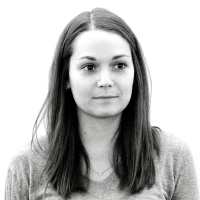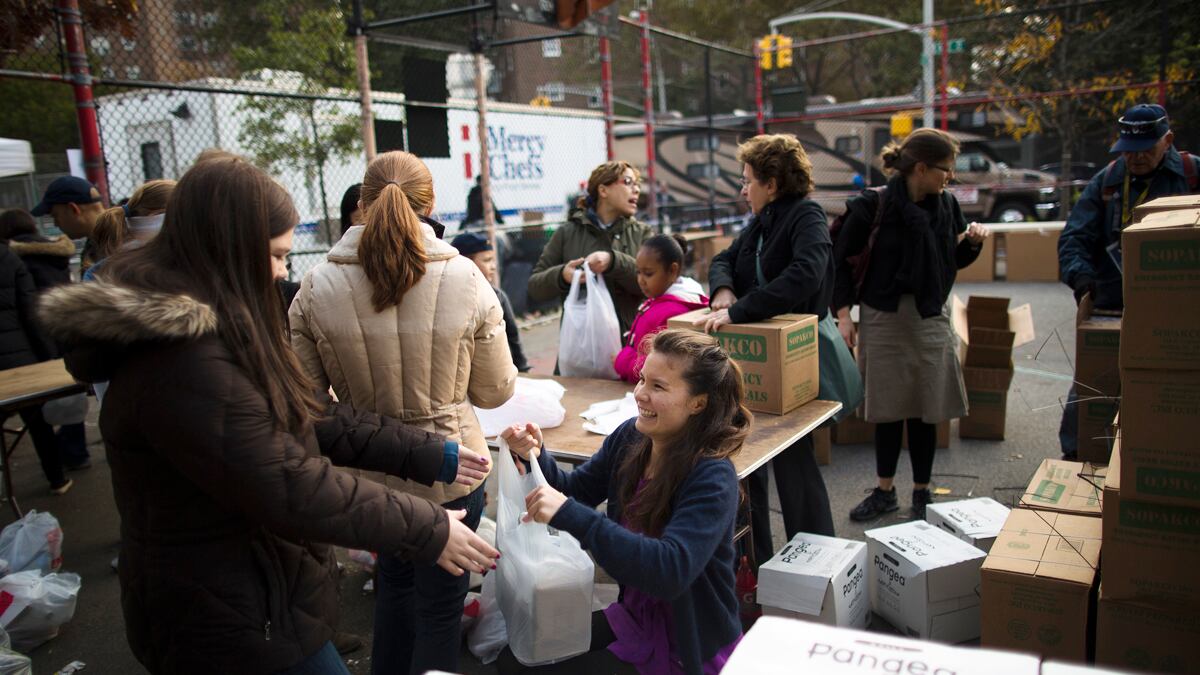Four days after Hurricane Sandy swept power and water from millions in New York and New Jersey, the streets of Manhattan’s Chinatown and Lower East Side were still quiet and dark. A few resilient vendors sat in front of darkened bodegas, selling prayer candles and batteries, as restless residents meandered. But the corner of Hester and Essex Street was bustling. And a crowd of people wearing blue strips of painter’s tape with the word “Volunteer” scribbled in permanent marker had set up shop as Occupy Sandy.

In the wake of the hurricane, Occupy Wall Street, which had been relatively quiet in recent months, had found a new cause to take on. On Tuesday morning, after the storm had subsided but New York City was still drying out, Michael Premo, whose relief efforts date back to Hurricane Katrina, and three of his friends from Occupy Wall Street headed to the Red Hook Initiative—a center where he’d worked in the past—to assess the situation. The outlook was grim. Premo said a worried volunteer told him: “We have no lights. We have no food. We’re in a situation here.” Premo said he told the volunteer: “You have a kitchen here. We will bring you resources and food.” That was the first community-based “hub,” as Premo refers to them. After posting a note on “Inner Occupy,” an online forum for those involved in the 99 percent movement, and blasting an email to friends, Occupy Sandy was born. Four days later, 13 centers had sprouted in destroyed communities from Rockaway Beach to Coney Island.
Talia Billig protested with Occupy Wall Street last fall. So when she was looking for an organization through which she could volunteer to help relieve those suffering after Sandy, she wasn’t surprised to find that the group making an effort in her own neighborhood was an OWS offshoot. “I live in Chinatown, and this is the sort of neighborhood that—for whatever reasons—wouldn’t get an organized citywide effort and that’s what Occupy is about,” Billig said. “It’s about common people helping common people.”
ADVERTISEMENT
Even though Billig’s own apartment on Canal and Orchard Streets had also been without power all week, she left the comfort of her friends in Brooklyn to return home and help her neighbors in need. “I’ve lived here for six years, and it really is a neighborhood. It’s one of the last neighborhoods in Manhattan, and I’m really happy to be able to help in any way I can.”
In front of the Committee Against Anti-Asian Violence (CAAAV) Center at 46 Hester Street, Billig met three other people, among the throngs of eager volunteers, who had both come from down the street and across the bridge to help their fellow New Yorkers. She teamed up with Ariel Bardi, who came from Park Slope after spending two days at Occupy Sandy’s relief headquarters in Red Hook; Stephen Cash, a long-time Lower East Sider; and Christina Reilly, a filmmaker who used to live in the Lower East Side and walked across the Williamsburg Bridge to her former neighborhood as soon as she’d heard about the relief movement. The four former strangers headed down the street hauling bags filled with water, food, candles, batteries, and other supplies.
“It’s overwhelming to see how incredibly organized and mobile everyone can be so quickly,” said Reilly. “Not that it’s surprising. It’s an island full of type As, so you know shit will get done.”
Reilly also noted the ease that Occupy Sandy—once organized—was not only able to rally more than enough supplies but also had people to deliver it. Outside of the powerless enclave below 39th Street, the life in the city seemed to be carrying on as if nothing had happened.
“There’s tons of stuff elsewhere, it’s just blocks away,” Reilly said. “It’s just moving it around and getting people to do the legwork, getting up all these stairs and everything.”
The team was surprised to find that their assigned address was only a three-floor walkup. They’d been prepared to do some climbing.
One flight up, Cash used his Mandarin skills to offer a single woman water and canned foods, as Reilly tries to determine what supplies the Chinese couple next door needs.
“She’s pretty picky about what she wants,” said Cash after he exited the first woman’s apartment. “She doesn’t want any beans. She’s Chinese, they don’t eat beans, so I gave her some rice.”
Another band of volunteers entered the building just as the grocery bag Reilly carried in broke, sending water bottles, cans, and batteries to the ground and rolling every which way. She quickly picked them up and threw the loose items into the new groups’ bags, and then headed downstairs to see if there’s anyone left living there.
On the first floor, Maria Ruiz welcomed Cash and Reilly into her friend Dina Santana’s home—where she’s been staying since Sunday, before the storm hit. Spanish-speaking voices carried from a small radio throughout the apartment, muffling the chirping of a small parrot in the kitchen.
Ruiz, speaking quietly in Spanish, accepted whatever was handed to her—fresh bread, wash clothes, water—but her face illuminated when Cash pulled out a flashlight and extra batteries. “Thank you! Thank you!” she exclaimed.
After saying goodbye to Ruiz and leaving her with a flier listing the nearest water and food stations, the team reconvened outside the building to make a game plan. They were only assigned this one address, but they still had bags full of supplies— meaning they are not ready to give up. The other volunteers then returned from across the street and announced they heard there is an apartment full of elderly people at 175 Eldridge Street, just a few blocks down. The two posses decided to join forces and set off hauling their rations down the street. About 90 minutes later, power was restored to most of lower Manhattan.





